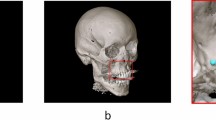Abstract
In complex orbital defects, typically the eye globe is retruded in a pathological position. This is associated with severe functional and cosmetic post-traumatic conditions. Characteristically, the posterior orbital floor and the medial wall of the bony orbit (=region of interest, ROI) is fractured where adequate reconstruction is crucial for a satisfactory surgical outcome but difficult to achieve. By introducing the concept of preshaped, navigated orbital implants, the repair of complex orbital fracture patterns could be significantly facilitated and improved. However, this ROI, delineated according to surgical criteria, cannot be defined by distinct anatomical landmarks because of the absence of reliable anatomical features. The determination of homologous surface points therefore remains a problem in such regions. The aim of this study was to provide a method for the assessment of the 3D shape of the ROI and of its variability, respectively. By aligning an anatomically determinable region that embeds the region of interest with a thin plate spline, transformation homology can be determined suitable for subsequent state-of-the-art shape analysis. First results of shape variations are illustrated and give hints into the future of optimized implant design.










Similar content being viewed by others
References
Hammer B: Orbital fractures: diagnosis, operative treatment, secondary corrections. Seattle: Hogrefe & Huber, 1995
Hammer B, Kunz C, Schramm A, deRoche R, Prein J: Repair of complex orbital fractures: technical problems, state-of-the-art solutions and future perspectives. Ann Acad Med Singapore 28(5):687–691, 1999. Review
Bookstein FL: Morphometric tools for landmark data, geometry and biology. Cambridge: Cambridge University Press, 1991/97
Zollikofer CPE, Ponce de León M: Virtual reconstruction, a primer in computer-assisted paleontology and biomedicine. New York: Wiley-Interscience, 2005
Dryden IL, Mardia KV: Statistical shape analysis. Chichester: Wiley, 1998
Lamecker H, Seebaß M, Hege HC, Deuflhard P: A 3D statistical shape model of the pelvic bone for segmentation. Proc SPIE—Med Imaging 2004: Image Processing 5370:1341–1351, 2004
Lamecker H, Kamer L, Wittmers A, Zachow S, Kaup T, Schramm A, Noser HR, Hammer B: A method for the three-dimensional statistical shape analysis of the bony orbit, CAS-H 2007, 4th International Conference on Computer Aided Surgery around the Head, Innsbruck, February 21–24, 2007
Rajamani KT, Nolte LP, Styner M: Bone morphing with statistical shape models for enhanced visualization. Proc SPIE Med Imaging 5367:122–130, 2004
Styner MA, Rajamani KT, Nolte LP, Zsemlye G, Szekely G, Taylor CJ, Davies RH: Evaluation of 3D correspondence methods for model building. Inf Process Med Imaging 18:63–75, 2003
Daniel R: Nonrigid registrations: concepts, algorithms, and applications. In: Hajnal JV, Hill DLG, Hawkes DJ Eds. Medical image registration. Boca Raton: CRC, 2001, pp 281–298
Cootes TF, Taylor CJ, Cooper DH, Graham J: Active shape models—their training and applications. Comput Vision Image Understanding 61/1:38–59, 1995
Floater MS: Parameterization and smooth approximation of surface triangulations. Comput Aided Geomet Des 14:231–250, 1997
Floater MS, Hormann K: Surface parameterization: a tutorial and survey. Advances in multiresolution for geometric modeling. Berlin: Springer, 2005, pp 157–186
Acknowledgement
The underlying surgical concept is formulated in a dedicated research project supported by the AO Research Fund of the AO Foundation (AO Research Grant 05-H37).
Author information
Authors and Affiliations
Corresponding author
Rights and permissions
About this article
Cite this article
Noser, H., Hammer, B. & Kamer, L. A Method for Assessing 3D Shape Variations of Fuzzy Regions and its Application on Human Bony Orbits. J Digit Imaging 23, 422–429 (2010). https://doi.org/10.1007/s10278-009-9187-7
Received:
Revised:
Accepted:
Published:
Issue Date:
DOI: https://doi.org/10.1007/s10278-009-9187-7




